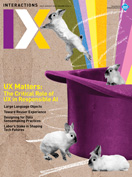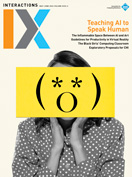Table of Contents
VOLUME XV.5 September + October 2008
-
WELCOME
-
EDITORIALInteractions
Richard Anderson, Jon Kolko
One of the main reasons interaction design is so magicaland so elusiveis because it touches on the very footprint of our collective soul: As we design explicitly for behavior, we affect implicitly our local culture and the fabric of our world. Transcending our local culture is our global dependence…
-
-
The importance of personal relationships
-
FEATUREExperiential aesthetics
Uday Gajendar
Why have a framework for understanding beauty? Isn't beauty simply obvious, like the infamous Supreme Court quip about pornography"You know it when you see it?" Perhaps for natural forms of beautyflowers, landscapes, animals, human bodiessubjective taste may suffice for coffee-table pundits and aesthetic philosophers alike. But in the high-stakes…
-
FEATUREIntimate interactions
Jeffrey Bardzell, Shaowen Bardzell
Few people would say that they wished their romantic lives were more like computing: efficient, automated, inorganic, and lightning fast. Yet technology is becoming increasingly implicated in the most intimate aspects of our lives and selves. At the same time we see calls in HCI to make technology more…
-
SUSTAINABLY OURSPersonal inventories in the context of sustainability and interaction design
William Odom, Eli Blevis, Erik Stolterman
What kind of relationships do people develop with the things they have at home? What is it that makes them keep and cherish certain things and discard others? And how is it possible to study these relationships in a way that could inform the design of sustainable interactive artifacts?…
-
LIFELONG INTERACTIONSMemory impairment is a family affair
Mike Wu
Amnesia is often used as a cinematic device to advance a movie's plot. Heroes lose their memories after a bump on the head, only to recover them following a subsequent bump. Yet what makes for popcorn-filled summer blockbusters rarely parallels how amnesia is truly experienced. Before I began designing…
-
FEATURELife at the margins
Christopher Le Dantec
Are food and shelter more important than a mobile phone? For the urban homeless, the answer to this question is unclear. Public phones are disappearing from cities, job services are increasingly accessible mainly through digital means, and modern society has become ever more accustomed to instant availability and dependent…
-
-
Old models no longer suffice
-
COVER STORYToto, I’ve got a feeling we’re not in Kansas anymore…
Meredith Davis
There is an ever-widening gap between where we are going in the practice of design and longstanding assumptions about design education. I'm not talking about the often-heard debates of skills versus concepts, theory versus practice, or professional versus liberal arts education. Instead, this is about the disorienting relationship between…
-
ON MODELINGDesign in the age of biology
Hugh Dubberly
In the early 20th century, our understanding of physics changed rapidly; now our understanding of biology is undergoing a similar rapid shift. Freeman Dyson wrote: "It is likely that biotechnology will dominate our lives and our economic activities during the second half of the twenty-first century, just as computer…
-
Ps and QsOpen, closed, or ajar?
Elizabeth Churchill, Mark Vanderbeeken
In May 2008 Harvard's Law School announced it would open access to the intellectual content created by its faculty members. This means content that is produced by faculty at Harvard will be available for us all to read. A driving issue behind this turn of events is the cost…
-
THE WAY I SEE ITSimplicity is not the answer
Donald Norman
Everyone wants simplicity. The same desires are there, whether the device is a new cell phone or a shop tool, the dashboard of an automobile or the choices offered while shopping in a store. "Why can't my technology be as easy to use as my garage-door opener?" asks one…
-
OK/CANCELApplied science
Tom Chi, Kevin Cheng
Footnotes DOI: http://doi.acm.org/10.1145/1390085.1390095 ©2008 ACM1072-5220/08/0900$5.00 Permission to make digital or hard copies of all or part of this work for personal or classroom use is granted without fee provided that copies are not made or distributed for profit or commercial advantage and that copies bear this notice…
-
FEATUREWhat should be automated?
Matti Tedre
One of the most influential figures in the early development of computer science, George Forsythe, argued in 1968 that "the question 'What can be automated?' is one of the most inspiring philosophical and practical questions of contemporary civilization [1]." Almost 20 years later, Peter Denning wrote that computer science…
-
TRUE TALESLiving in the overlap
Steve Portigal
Here's a bunch of stuff I haven't tried: "Project Runway," "High School Musical," "American Pie" movies, robot wars, molecular gastronomy, Halo 3, "Dancing With the Stars," "Frisky Dingo," sudoku, biopics, "House," "Desperate Housewives," Portishead, Fifty Cent, Dane Cook, The Da Vinci Code, The Life of Pi, Marley & Me,…
-
-
Factors to no longer overlook
-
FEATUREIgnorance of interaction programming is killing people
Harold Thimbleby
Almost a century ago, the April 9, 1929, issue of the International Herald Tribune reported the death of three young brothers. All of them had been given a dose of thallium acetate 10 times what was intended, because of a decimal-point error. Decimal-point errors occur regularly. For instance, on…
-
FEATUREMental and conceptual models, and the problem of contingency
Charles Hannon
An 1878 brochure (at left) from the New England Telephone company, "How to Make a Telephone Call," explains, with illustrations, the use of its new instrument. One of the drawings "represents a person calling attention by pressing the knob at the end of Bell Box, and turning the crank,…
-
TIMELINESWhy Engelbart wasn’t given the keys to Fort Knox
Jonathan Grudin
When I was in school, history was presented as an immutable timeline, stretching from the dawn of writing to about World War II, after which it was too controversial for children. My forays into the early days of HCI have revealed less constancy; history changes as our perspective changes.…
-
FEATURELet’s get physical
Gretchen Anderson
Increasingly, interactions are taking place on screens and devices outside the desktop/PC environment in products sometimes referred to as "convergent." Converging are the traditionally distinct worlds of screen-based interaction design and the industrial design of physical objects. As a result, interdisciplinary design teams must collaborate to choose physical controls…
-
FEATUREThe researcher-tool mismatch
Rob Tannen
Pity the typical user researcherhand cramped from writing pages of subsequently illegible observation notes, arm sore from trying to hold a camera steady for hours on end, head aching from trying to assimilate so much information. And if all goes well, that was the easy part. Returning to the…
-
-
Interactions Cafe
-
On addressing wicked problems…
Richard Anderson, Jon Kolko
Jon: A lot of the discourse that surrounds interaction design speaks to the large, cultural change it can afford. When I used to teach, my students would become enamored with the possibilities of design and would make grandiose and unintentionally trivializing statements like "World hunger? It's just a design…
-



